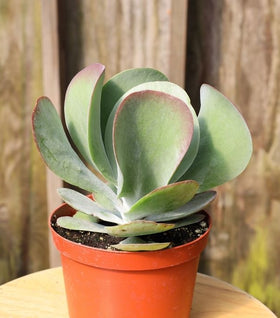Kalanchoe Plants for Sale Online
Kalanchoe plants are native to Madagasgar and thrive in arid environments, making them perfect for houseplants. Kalanchoe plants are perfect for first-time plant parents for their ease of care and attractive leaves. They are slow-growing plants, on average taking between two and five years to reach mature size. This makes kalanchoe perfect for smaller areas or use in mixed containers.
If you're looking to grow succulent plants but worry that succulents are not very showy or colorful, look no further than the Kalanchoe family. As members of the succulent family of plants, Kalanchoe is a relatively hands-off type of plant, preferring plenty of sunlight and well-drained soil.
Kalanchoes tolerate a wide variety of indoor temperatures but usually will not bloom during the dark winter months. In the spring, they will burst forth with colorful flowers that can last several weeks. Flowering will be sporadic throughout the year, as long as the plant receives the proper light and are pruned correctly.
Deadheading or removing the spent flower stalks between flowering cycles reducing the amount of water the plant receives for a few weeks after. This process allows the plant to "reset" after flowering and begin the process over.
Choosing the best light for Kalanchoe
Kalanchoe plants need a lot of bright sunlight to bloom. They should be placed in a room where they receive the most natural light possible. A south-facing window is best, but an eastern facing window will do. Filtered sun is best, similar to the sunlight through a sheer curtain. Avoid placing them on windowsills or in direct sunlight when possible.
Direct sunlight can scorch the leaves, which will potentially burn the new leaves and reduce flowering.
Choosing the Best Soil for Kalanchoe Plants
Kalanchoe plants grow best in well-drained potting soil. This is a good chance for growers to create custom-blended houseplant soil. A 50/50 blend of Espoma Cactus soil and Espoma Potting Mix works well. You can experiment with different combinations and ratios to suit your style, but you decide to blend your soil, remember that a good mix should contain perlite, vermiculite, and peat moss.
Another tip; To ensure proper drainage and avoid an overly-moist environment, plant your Kalanchoe in a clay pot. Clay or Terra Cotta Pots can help wick excess water from the soil.
Watering Kalanchoe Plants
If you're a forgetful waterer, Kalanchoe Plants may be the perfect plant for you. Kalanchoes do well with very little water. During the spring, summer, and fall, a good soaking every 20 days is sufficient. In the winter watering, every 30 days is adequate. Let the soil of Kalanchoe dry out completely in between waterings.
If you arent sure whether or not the plants' soil has dried out enough to water again, stick your finger into the top inch or so of soil; if the soil feels moist, come back in a few days. Kalanchoe plants are succulent plants, and therefore the leaves can store water. This makes the kalanchoe plant the camel of the plant world.
Fertilizing Kalanchoe Plants
Fertilizing Kalanchoe Plants is especially important when they are beginning to bloom. Feed with a well-balanced fertilizer like Jacks Classic Houseplant Fertilizer once a month during the spring and summer months. If you find that your Kalanchoe plants are not blooming and you've given them plenty of light, try a fertilizer specially formulated to help plants flower, such as Jack's Blossom Booster. This type of fertilizer is blended to have higher potassium levels, which allows plants to produce flower buds.
Temperature and humidity levels for Kalanchoe Plants
Generally, kalanchoe plants will thrive at temperatures ranging from 55–80 degrees, so indoor temperatures should not be a problem during any time of the year.
Kalanchoe plants are not picky about humidity levels and do not require certain moisture levels in the air. It is not recommended to mist your Kalanchoes as they are quite happy in dry environments.

